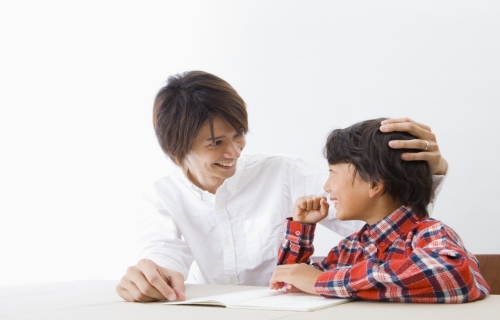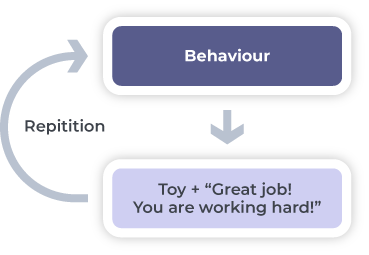Reinforcement

Reinforcement is an environmental variable that immediately follows a behaviour and that increases or maintains the frequency of this behaviour. Reinforcement is an indispensable component of learning and can be used effectively with anyone, regardless of their cognitive level or their ability to communicate.
Basic principles of reinforcement
Reinforcement is a consequence, that is, an activity, action, or condition that immediately follows a behaviour.
Consequences can be reinforcing (pleasant) or punitive (unpleasant). When the consequences are reinforcing, the behaviour is likely to continue and even intensify. If the consequences are punitive, the behaviour may fade away or stop. It may accelerate the learning process by creating the motivation to maintain a specific behaviour.
Reinforcement is a phenomenon that occurs continuously in our everyday lives, sometimes even without being noticed. A smile, an interaction with a friend, a child’s laugh, or even a feeling of pleasure can be reinforcing conditions that will increase the probability that the behaviour that precedes them will happen again. This is what is called naturally occurring reinforcement.

Reinforcement may also be deliberately planned in a context where we want to teach a new behaviour or skill, or even increase the frequency of a skill that is already in your child’s repertoire. For example, your child could be offered a small candy when they go to the washroom on their own or your teenager could be offered a little money when they perform some household tasks.
When used intentionally, reinforcement must represent clear feedback to your child. In other words, it must clearly show the correct behaviour that is expected of him or her and your child must be able to easily distinguish when the reinforcement is available and when it is not. Your child’s motivation lies in their desire to obtain the reinforcers available.
Identifying potential reinforcers
A reinforcer is an item or event presented immediately after the behaviour and that encourages repetition of this behaviour. There is an infinite variety of elements that can be used as reinforcers, including praise, attention, food, activities, toys, money, and tokens.
Consequences do not have the same effect on all individuals. A smile, for example, could act as a reinforcing consequence for one person and have absolutely no effect on someone else.
To use reinforcement effectively, it is important to determine the potential reinforcers unique to each person. We are therefore seeking to identify preferred items, activities, or events. There are many methods that can be used to identify potential reinforcers.
Free Operant - Preference Assessment
Trial-based - Preference Assessment
Validate the function of reinforcers
Even when your child has shown a preference for an item or an activity, you need to verify that this item can truly function as a reinforcer, that is, that it can increase the probability that a behaviour will be repeated. The only way of knowing if an item or activity is really acting as a reinforcer is to observe and measure its effect on a target behaviour.
Another important thing to note is that an item may act as a reinforcer for a specific behaviour, but not have any effect on another behaviour. For example, a parent offers their daughter a little money when she does household chores and she continues doing these tasks regularly. Then the parent decides to offer their daughter a little money when she mows the lawn, yet the girl does not mow the lawn again. The money thus acts as a reinforcer for the target behaviour Doing household chores but does not act as a reinforcer for the target behaviour Mowing the lawn.
Motivation
Here is a description of the impact of motivation on consequences:

Pairing
Pairing is a process that makes it possible to create new reinforcers by associating a known reinforcer to another neutral item or event. It is an important process, especially for children that respond to a limited number of reinforcers. One of the most common examples of pairing is when you associate a preferred toy with lots of social praise and/or attention. If done well, you should see that the social praise/attention, through its association with the toy, becomes reinforcing for your child even in the absence of the toy. This means that you can influence your child’s behaviour in any given situation or context more easily, as you do not have to bring along a toy or other item with you.
Pairing makes it possible to create reinforcers commonly available in the natural learning environment. Whereas planned reinforcement is sometimes necessary when you are teaching a new skill or behaviour, it is much more effective and practical to use naturally occurring reinforcement. For example, it may be necessary to offer your child a planned reinforcer (an item or a favourite toy) when they are learning to strike up a conversation with peers. However, it would be much more effective to pair these with social reinforcers, such as smiles or nods. Your child’s behaviour of having a conversation with peers could be reinforced more naturally that way.
Characteristics of effective reinforcement
When implementing reinforcement, several factors may influence its effectiveness. Consider these four important factors when you use reinforcement with your child:
Printable summary: Characteristics of effective reinforcement (pdf)

Final thoughts
As you can now see, reinforcement is an indispensable component of your child’s learning. The concepts we have reviewed should help you on your way to being more aware and capable of using reinforcement in a purposeful and systematic way to teach your child new skills or behaviours as well as to strengthen existing skills.